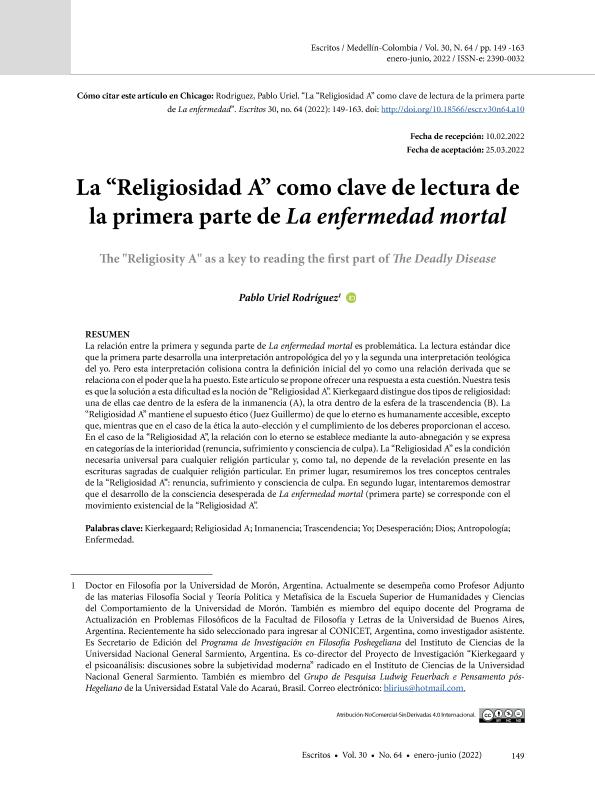Mostrar el registro sencillo del ítem
dc.contributor.author
Rodríguez, Pablo Uriel

dc.date.available
2023-02-09T12:11:30Z
dc.date.issued
2022-05
dc.identifier.citation
Rodríguez, Pablo Uriel; La «Religiosidad A» como clave de lectura de la Primera Parte de La enfermedad mortal; Universidad Pontificia Bolivariana. Escuela de Teología, Filosofía y Humanidades; Escritos; 30; 64; 5-2022; 149-163
dc.identifier.issn
0120-1263
dc.identifier.uri
http://hdl.handle.net/11336/187445
dc.description.abstract
La relación entre la primera y segunda parte de La enfermedad mortal es problemática. La lectura estándar dice que la primera parte desarrolla una interpretación antropológica del yo y la segunda una interpretación teológica del yo. Pero esta interpretación colisiona contra la definición inicial del yo como una relación derivada que se relaciona con el poder que la ha puesto. Este artículo se propone ofrecer una respuesta a esta cuestión. Nuestra tesis es que la solución a esta dificultad es la noción de "Religiosidad A". Kierkegaard distingue dos tipos de religiosidad: una de ellas cae dentro de la esfera de la inmanencia (A), la otra dentro de la esfera de la trascendencia (B). La "Religiosidad A" mantiene el supuesto ético (Juez Guillermo) de que lo eterno es humanamente accesible, excepto que, mientras que en el caso de la ética la auto-elección y el cumplimiento de los deberes proporcionan el acceso. En el caso de la "Religiosidad A", la relación con lo eterno se establece mediante la auto-abnegación y se expresa en categorías de la interioridad (renuncia, sufrimiento y consciencia de culpa). La "Religiosidad A" es la condición necesaria universal para cualquier religión particular y, como tal, no depende de la revelación presente en las escrituras sagradas de cualquier religión particular. En primer lugar, resumiremos los tres conceptos centrales de la "Religiosidad A": renuncia, sufrimiento y consciencia de culpa. En segundo lugar, intentaremos demostrar que el desarrollo de la consciencia desesperada de La enfermedad mortal (primera parte) se corresponde con el movimiento existencial de la "Religiosidad A".
dc.description.abstract
The relationship between the first and second parts of The Deadly Disease is problematic. The standard reading says that the first part develops an anthropological interpretation of the self and the second a theological interpretation of the self. But this interpretation collides with the initial definition of the self as a derivative relationship that relates to the power that has placed it. This article aims to provide an answer to this question. Our thesis is that the solution to this difficulty is the notion of "Religiosity A." Kierkegaard distinguishes two types of religiosity: one of them falls within the sphere of immanence (A), the other within the sphere of transcendence (B). "Religiosity A" maintains the ethical assumption (Juez Guillermo) that the eternal is humanly accessible, except that, while in the case of ethics, self-choice and fulfillment of duties provide access to it. In the case of "Religiosity A," the relationship with the eternal is established through self-denial and is expressed in categories of interiority (renunciation, suffering and guilt awareness). "Religiosity A" is the universal necessary condition for any particular religion and, as such, does not depend on the revelation present in the sacred scriptures of any particular religion. First, we will summarize the three central concepts of "Religiosity A": renunciation, suffering, and guilt awareness. Secondly, we will try to show that the development of the desperate consciousness of The Deadly Disease (part one) corresponds to the existential movement of "Religiosity A."
dc.format
application/pdf
dc.language.iso
spa
dc.publisher
Universidad Pontificia Bolivariana. Escuela de Teología, Filosofía y Humanidades
dc.rights
info:eu-repo/semantics/openAccess
dc.rights.uri
https://creativecommons.org/licenses/by-nc-nd/2.5/ar/
dc.subject
KIERKEGAARD
dc.subject
INMANENCIA
dc.subject
DESESPERACIÓN
dc.subject
ANTROPOLOGÍA
dc.subject.classification
Filosofía, Historia y Filosofía de la Ciencia y la Tecnología

dc.subject.classification
Filosofía, Ética y Religión

dc.subject.classification
HUMANIDADES

dc.title
La «Religiosidad A» como clave de lectura de la Primera Parte de La enfermedad mortal
dc.title
The "Religiosity A" as a key to reading the first part of The Deadly Disease
dc.type
info:eu-repo/semantics/article
dc.type
info:ar-repo/semantics/artículo
dc.type
info:eu-repo/semantics/publishedVersion
dc.date.updated
2023-02-08T15:34:45Z
dc.identifier.eissn
2390-0032
dc.journal.volume
30
dc.journal.number
64
dc.journal.pagination
149-163
dc.journal.pais
Colombia

dc.journal.ciudad
Medellín
dc.description.fil
Fil: Rodríguez, Pablo Uriel. Consejo Nacional de Investigaciones Científicas y Técnicas; Argentina. Universidad de Morón; Argentina. Universidad Nacional de General Sarmiento. Instituto de Ciencias; Argentina. Universidad de Buenos Aires. Facultad de Filosofía y Letras; Argentina. Universidad Estatal Vale do Acaraú; Brasil
dc.journal.title
Escritos
dc.relation.alternativeid
info:eu-repo/semantics/altIdentifier/doi/http://doi.org/10.18566/escr.v30n64.a10
dc.relation.alternativeid
info:eu-repo/semantics/altIdentifier/url/https://revistas.upb.edu.co/index.php/escritos/article/view/7554
dc.relation.alternativeid
info:eu-repo/semantics/altIdentifier/url/http://www.scielo.org.co/scielo.php?script=sci_arttext&pid=S0120-12632022000100149&lng=en&nrm=iso&tlng=es
Archivos asociados
